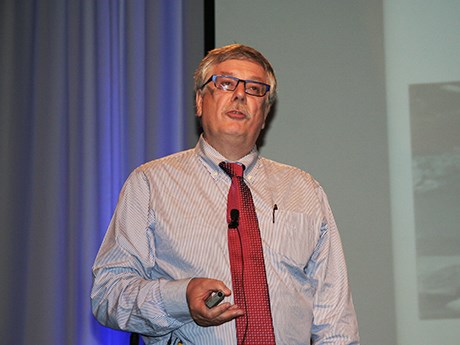Within 10 years, 40 per cent of Rio Tinto’s copper production will come from underground mines with production rates of 100,000 tonnes or more per day. To achieve this target, the company is looking at driving 60 kilometres of development per year, sinking 10 production and ventilation shafts and purchasing 500 pieces of mobile equipment.
These were some of the staggering metrics keynote speaker Allan Moss shared with delegates at the MassMin 2012 conference in Sudbury June 11th.
“This is a huge change for a company that is known for its open pit operations,” said Moss, who serves as general manager of Rio Tinto’s Underground Technology Centre.
The transition from open pit to underground mining is a consequence of increasing demand and dwindling supply.
“Copper demand is increasing,” said Moss. “We’ve all heard the story about China and India. At the same time, it’s becoming more and more difficult to supply that demand from conventional open pits. The other thing that’s happening is that our grades are falling around the world, so we’re getting squeezed.
Until now, to go after ore at depth, mining companies would use conventional underground mining methods such as open stoping or cut and fill, but these methods aren’t economically viable for large, low-grade deposits, said Moss.
“So, we’re going to have to change the way we do things. We’re going to have to go underground in a different way.”
Block caving, the method of choice for large, low-grade underground deposits, is used to produce between 30,000 and 34,000 tonnes per day at Rio Tinto’s Palabora Mine, which transitioned from open pit to underground mining in 2000. Other existing and planned caving operations include Northparkes in Australia (20,000 tonne per day), Oyu Tolgoi in Mongolia and Resolution in Arizona, a proposed 100,000-tonne per day operation.
Probably the largest caving operation in the world is being planned for Grasberg in Indonesia, which will produce 160, 000 tonnes per day at full capacity by 2021. An additional block cave mine planned for Grassberg’s DMLZ orebody will produce an additional 80,000 tonnes per day, bringing total daily production to 240,000 tonnes.
Chile’s Codelco already operates several block cave mines, including Andina and El Teniente, while plans for Chuquicamata call for a 140,000 tonne per day operation beneath the depleted one kilometre deep pit.
“Operating costs for block cave mining range between $5 to $7 per tonne, but what you’re getting is a tonne of ore,” said Moss. “Operating cost for a big open pit are $1 to $1.20 per tonne of material moved, but we have to move four tonnes of waste to get one tonne of ore, so the operating costs are comparable.
“The difference is in the capital. For block caving, we’re spending 70 per cent of the capital before we get any revenue, so the risk profile from an investment point of view is different.”
Lead-time to full production can stretch to 15 or more years. By way of example, said Moss, “we constructed the portals at Grasberg in 2004 and full production is planned for 2022. That’s an 18-year construction period. By using different technologies to shave a year or two years off that, we could save a lot of money.”
This is where the concept of the ore factory and the use of tunnel boring technology enter the picture.
But optimizing the economics of block cave operations will require the development of much more sophisticated measuring techniques, said Moss.
“We will typically have 1,000 drawpoints a day to manage and, to do that, we’ve got to know the grade. Now, we send down samplers, but we don’t get to every drawpoint on a frequent basis, so we have to automate that.”
Block cave operations also have to do a better job measuring air underground, “and we have to know what’s in the buckets and where the ore came from.”
The longevity of block cave mines poses another challenge, said Moss.
“We’re building block cave mines to last up to 50 years, so the infrastructure has to last that length of time. It’s not like a gold mine that will be mined out in five years,” so the quality of the construction has to be up to the standards of civil construction.
Our experience base relating to supercaves is still in its infancy given that there are only 10 or so caving operations in the world, and what Moss calls “the feedback loop” is compromised by the fact that the engineers who design a block cave will more than likely be retired by the time an operation reaches full production.
The answer, said Moss, is to move toward “a much more rigorous scientific approach to better understand cave performance and rock mass behaviour.”



